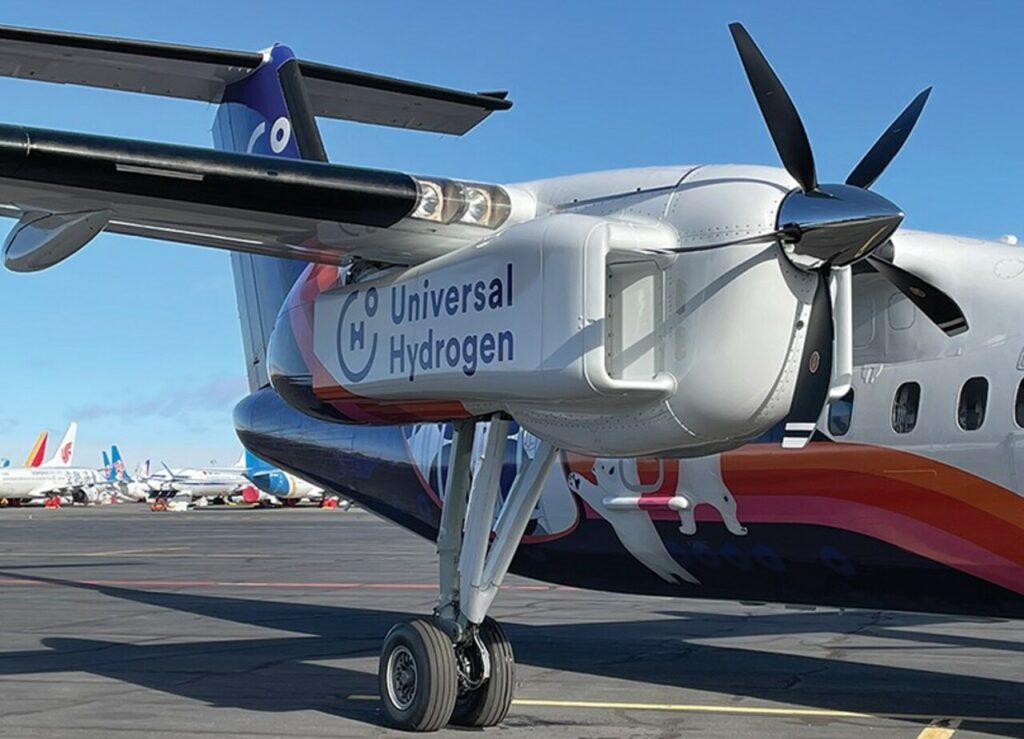When Universal Hydrogen’s De Havilland Dash 8 hydrogen fuel cell-powered testbed first flew earlier this month, its powertrain included a propeller designed and tested for the experimental aircraft by Hartzell Propeller.
Hydrogen fuel cell technology
Hydrogen fuel cell technology for aircraft is a relatively new and promising area of research and development. It involves using hydrogen as a fuel source to power aircraft instead of traditional fossil fuels.
The basic idea behind hydrogen fuel cells is that they convert hydrogen gas into electricity through a chemical reaction, which can then be used to power an electric motor that drives the aircraft’s propulsion system.
The only byproduct of this reaction is water, making it a clean and environmentally friendly alternative to traditional fossil fuels.
There are several potential benefits to using hydrogen fuel cells in aircraft. One of the main advantages is that hydrogen is a highly efficient fuel source, meaning that it can produce a lot of energy for a relatively small amount of fuel.
Additionally, hydrogen fuel cells are quiet and emit no pollutants, making them an attractive option for reducing noise and air pollution around airports.
However, there are also several challenges associated with hydrogen fuel cell technology for aircraft. One of the main challenges is that hydrogen is less energy-dense than traditional fossil fuels, which means that larger tanks or more frequent refueling may be required.
Additionally, the infrastructure for producing, storing, and transporting hydrogen fuel is currently limited, which could present logistical challenges for widespread adoption.
Despite these challenges, there has been significant interest in developing hydrogen fuel cell technology for aircraft, and several companies and research organizations are actively working on developing and testing hydrogen-powered aircraft.

Modified propeller for green technology
As more becomes known about this leading-edge technology, so we learn more about the modifications that are being made to traditional aircraft technology to facilitate its uptake.
For example, the propeller utilised on Universal Hydrogen’s experimental aircraft was role modified.
The 91-inch diameter five-blade swept airfoil carbon fiber propeller utilized derivative blades, hub and retention components from an existing 14 CFR Part 35 certified propeller.
The specially designed Hartzell propeller is smaller than the standard Dash 8 propeller, but provided thrust to keep the aircraft airborne when the other jet fuel powered turbine engine was throttled back during first flight.
“This project with Universal Hydrogen is one of many programs where Hartzell Propeller is working with and supporting advanced air mobility manufacturers. Hartzell Propeller has been around for over a hundred years, and carbon-free flight can power our next century,” said Hartzell Propeller President JJ Frigge.
“We’ve been working with this team for almost two years as we step up our investments working on future new aircraft design opportunities. Hartzell Propeller is pleased to be a part of this historic first flight of a hydrogen fuel cell-powered regional airliner,” Frigge added.
Customised propeller governor
Not only was the propeller itself task specific for the experimental aircraft running green fuel technology, but the propeller governor unit was similarly role modified.
Hartzell customized a propeller governor for Universal Hydrogen and continues to develop governor advancements for green-powered aircraft.
In the first test flight, one of the airplane’s turbine engines was replaced with Universal Hydrogen’s fuel cell-electric, megawatt-class powertrain. The other aircraft engine was powered by conventional fossil fuel for safety.
Universal Hydrogen’s first flight marked the largest hydrogen fuel cell-powered airplane ever to take to the skies and the largest airplane to cruise principally on hydrogen.
The airplane, nicknamed Lightning McClean, flew for 15 minutes, reaching an altitude of 3,500 MSL.
The flight was conducted under an FAA Special Airworthiness Certificate and the program is planned to culminate in 2025 with entry into passenger service of ATR 72 regional aircraft converted to run solely on hydrogen.
About Universal Hydrogen
Universal Hydrogen is building a hydrogen logistics network to fuel the future of aviation, today. Hydrogen is the ideal fuel for flight and will power aviation’s new golden age, where planes are powered by renewables and emit nothing but water.
The company’s modular hydrogen capsules move over the existing freight network from production directly to the airplane anywhere in the world.
Universal Hydrogen is also working to certify a powertrain conversion kit to retrofit existing regional aircraft to fly on hydrogen.
The company has gathered the world’s leading aviation and hydrogen talent to give the industry the option of clean flight, forever.
About Hartzell Propeller
Hartzell Aviation’s flagship company is Hartzell Propeller, the global leader in advanced technology aircraft propeller design and manufacturing for business, commercial and government customers.
The company designs next-generation propellers with innovative blended airfoil technology and manufactures them with revolutionary machining centers, robotics, and custom resin transfer molding curing stations.









